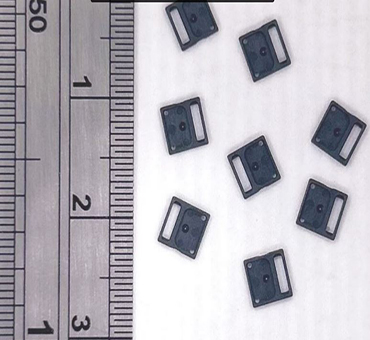
The micro molding technique offers several advantages in terms of precision, machining, and cost. Amidst the plenty benefits of this process, here are some of the significant ones:
This advanced injection molding technique excels in achieving high levels of precision and intricate geometries. The process allows for the production of extremely small and detailed components with tight tolerances. Advanced machining techniques, such as CNC and EDM, enable the creation of micro-sized cores, cavities, and features with exceptional accuracy.
This precision is crucial in medical devices, electronics, and micro-optics industries, where even minor deviations can significantly impact performance. This technique ensures consistent replication of complex designs, enabling the production of precise and reliable plastic parts.
The procedure also supports various material options, including high-performance polymers and engineered thermoplastics. These materials offer excellent mechanical properties, chemical resistance, and thermal stability.
The compatibility of different materials allows for the manufacturing of components tailored to specific applications. The selection of materials can be optimized for biocompatibility, electrical conductivity, heat resistance, etc. This versatility in material selection ensures that micro molded parts meet the desired functional requirements.
Unlike conventional injection molding, this technique provides significant cost advantages. The tools it needs are smaller in size and more affordable, resulting in cost savings. For instance, the reduced clamping force required allows for using smaller, less expensive machines. As a result, the cost of micro-molding can be approximately 40% lower compared to full-scale tooling costs.
Moreover, this process significantly reduces production costs through shorter cycle times. The process involves using micro molds typically made from aluminum, which enables faster and more cost-effective machining. The use of compact barrels, fewer mold cavities, and smaller runners also contribute to cost reduction. These factors collectively contribute to the overall cost-effectiveness of the micro molding process. The small size of micro components also allows for efficient use of materials, minimizing waste.

Micro molding presents unique challenges from precise tooling and material flow control to stringent quality control and scalable production. Let’s examine some of them.
Achieving exceptional accuracy and precision is paramount in mold construction and micro parts production. Even slight misalignments during injection molding design can significantly impact the quality of the small-sized plastic parts. In micro-molding with liquid silicone rubber, additional precision is necessary when mixing the materials, incorporation of color, and precise dosing to ensure process stability and repeatability.
The construction of molds poses various engineering challenges, primarily related to mold design. Mold design must incorporate critical elements to ensure consistent alignment of the mold halves and enable precise demolding of the parts. The mold design must also facilitate consistent quality and longevity to support high-capacity output. This is because a typical micro injection mold is expected to produce millions of parts throughout its lifespan.
It’s critical to achieve proper material flow. The small size of the mold cavities and thin walls of micro parts can lead to challenges in filling the mold properly. Careful consideration must be given to factors such as injection speed, pressure, temperature, and gate design to ensure uniform and consistent material flow.
Balanced cavity pressures in micro injection molds ensure consistent filling. Good valve gate technology and a well-balanced cold deck prevent short shots or incomplete filling. Cavity temperature affects material curing and part formation. Proper nozzle cooling aids the transition from cooling during filling to heating during vulcanization.
Direct gating is ideal if there’s enough space for a gate. Otherwise, alternative gating methods like film, edge, or tunnel gates are used. Overflows can ensure complete part filling and reduce trapped air risks. Runners aid in handling operations like slitting, marking, printing, packaging, and assembly, improving workflow efficiency.
The small dimensions of micro-sized components make it difficult to inspect the parts for defects or dimensional accuracy visually. You may need non-destructive testing techniques like high-resolution imaging systems or advanced metrology equipment to detect and measure micro-level defects.
It is also important to implement strict quality control measures. They include process monitoring and statistical analysis, which should be implemented to maintain consistent quality throughout production.
While the technique is well-suited for small-scale production of micro-sized components, scaling up the production can pose challenges. Additionally, the selection of suitable materials and the availability of raw materials in sufficient quantities can impact the scalability of the process.
Therefore, designers and engineers must carefully evaluate cycle time, mold durability, and machine capacity. This will help ensure efficient and cost-effective production at larger volumes.